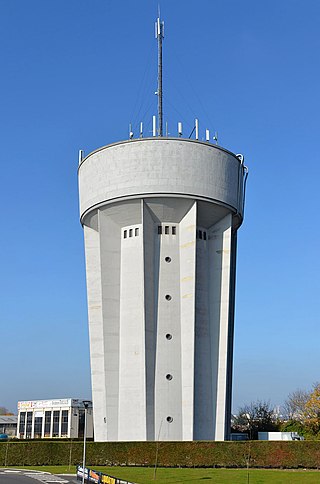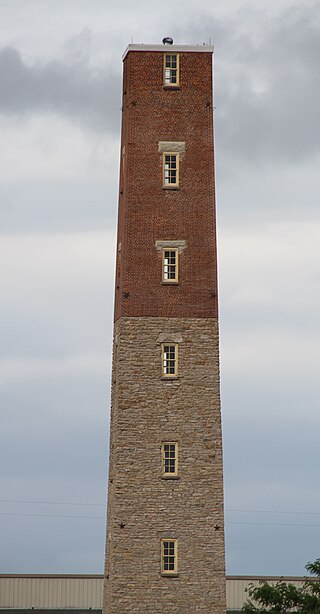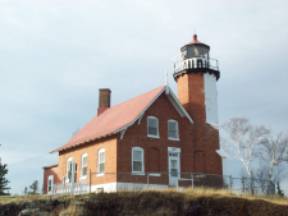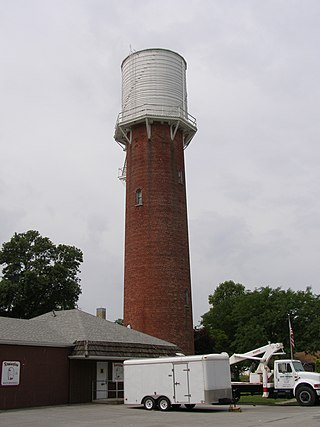
A water tower is an elevated structure supporting a water tank constructed at a height sufficient to pressurize a distribution system for potable water, and to provide emergency storage for fire protection. Water towers often operate in conjunction with underground or surface service reservoirs, which store treated water close to where it will be used. Other types of water towers may only store raw (non-potable) water for fire protection or industrial purposes, and may not necessarily be connected to a public water supply.

The Shot Tower located in Dubuque, Iowa, is one of the last remaining shot towers in the United States. It is listed on the National Register of Historic Places and remains a recognized symbol of the city. At its location near the Mississippi River, the Tower can be seen from the riverwalk and is currently undergoing extensive renovations. It stands 120 feet 5 inches (36.70 m) tall.

Grimsby Dock Tower is a hydraulic accumulator tower and a maritime landmark at the entrance to the Royal Dock, Grimsby, in North East Lincolnshire, England. It was completed on 27 March 1852, based on William Armstrong's idea of the hydraulic accumulator, with the purpose of containing a 30,000-imperial-gallon (140,000 L) reservoir at a height of 200 feet (61 m), that was used to provide hydraulic power to power the machinery of the Grimsby Docks. The extreme height of the tower was necessary to achieve sufficient pressure, and as a result of this, the tower can be seen for several miles around, even far inland on the north bank of the Humber estuary in villages such as Patrington.

The Cana Island lighthouse is a lighthouse located just north of Baileys Harbor in Door County, Wisconsin, United States.

Thomas Hill Standpipe, which holds 1,750,000 US gallons (6,600,000 L) of water, is a riveted wrought iron tank with a wood frame jacket located on Thomas Hill in Bangor, Maine, United States. The metal tank is 50 feet (15 m) high and 75 feet (23 m) in diameter. Built in 1897, it is an architecturally distinctive city landmark, and was listed on the National Register of Historic Places in 1974.

Eagle Harbor Light is an operational lighthouse at Eagle Harbor, in Keweenaw County in the state of Michigan. It sits on the rocky entrance to Eagle Harbor and is one of several light stations that guide mariners on Lake Superior across the northern edge of the Keweenaw Peninsula. The original lighthouse, built in 1851, was replaced in 1871 by the present red brick structure, which is a Michigan State Historic Site and listed on the National Register of Historic Places.

The Paxton Water Tower and Pump House are a historic water tower and pump house located at 145 S. Market St. in Paxton, Illinois.

The Lena Water Tower is a water tower located in the village of Lena, Illinois, United States. It was built in 1896 following two decades of problems with structure fires in the village. The current water tower is the result of a second attempt after the first structure proved to be unstable. The tower stands 122.5 feet (37.3 m) tall and is built of limestone and red brick. The current stainless steel water tank holds 50,000 gallons and replaced the original wooden tank in 1984. The site has two other structures, an old power plant building and a 100,000 US gallon reservoir. The Lena Electric Plant Building was constructed in 1905 and the reservoir completed in 1907. The Lena Water Tower was listed on the U.S. National Register of Historic Places in 1997; the reservoir was included as a contributing property to the listing.

The Ransom Water Tower is a former water tower in the LaSalle County, Illinois, village of Ransom. It was added to the U.S. National Register of Historic Places in 1990.

The Clock Tower in Rome, Georgia is one of the oldest landmarks in the city. The Clock Tower is located at the summit of Clock Tower Hill one of the Seven Hills of Rome.

The Water Tower was built in 1897 by Challenge Wind and Feed mill Company of Batavia, Illinois. This is a rare wooden tank atop a brick tower type of water tower. Built on a limestone foundation, it is 140 feet (43 m) tall and about 20 feet (6.1 m) in diameter. The brick walls are 2 feet (0.61 m) thick.
The Frenchville Railroad Station and Water Tank are a historic railroad museum property in Frenchville, Maine. The station and water tank were built in 1910 by the Bangor & Aroostook Railroad (B&A) and were added to the National Register of Historic Places on June 20, 1995. The station was retired in 1971. The water tower became obsolete in 1958 when the diesel locomotive replaced the steam locomotive. The Town of Frenchville purchased the water tank from Bangor & Aroostook Railroad and used it as a water reservoir for the fire department until 1981. The Frenchville Historical Society took over maintenance of the site in 1985.

The Clarion County Courthouse and Jail is a historic courthouse and jail located in Clarion, Clarion County, Pennsylvania. The courthouse was built between 1883 and 1885, and is a 3 1/2-story, brick Victorian structure with Classical details measuring 78 feet, 8 inches, wide and 134 feet deep. It has a 213 foot tall, 25 feet square, clock tower. The jail was built between 1873 and 1875, and is a half brick / half sandstone building, located behind the courthouse.

The Oregon Water Tower and Pump House is a metal tower with a brick pump house built in 1899 in Oregon, Wisconsin. It was added to the National Register of Historic Places in 2007.

The Monroe Water Tower is a historic water tower built in 1889 in Monroe, Wisconsin. It was added to the National Register of Historic Places in 2005.

The Evansville Standpipe is a historic water tower located in Evansville, Wisconsin. The 80-ft tall steel tower was built in 1901 by the Chicago Bridge & Iron Company, as part of the development of the local water supply system, spurred on by a devastating fire in 1896 that destroyed a large section of downtown Evansville. It was added to the National Register of Historic Places in 2008.

The City of Beloit Waterworks and Pump Station was built in 1885 in Beloit, Wisconsin just below a hill on top of which sits the Beloit Water Tower. It was added to the National Register of Historic Places in 1990.

The Cathance Water Tower is a historic water tower at Cathance Road and Beechwood Drive in Topsham, Maine. Probably built in the late 19th century, it is an extremely rare surviving example of a residential wooden water tower built for a single residence. It was listed on the National Register of Historic Places in 2001. It is now owned by the town.

The Ogilvie Watertower is a historic water tower in Ogilvie, Minnesota, United States, built in 1918. It was listed on the National Register of Historic Places in 1980 for having local significance in the themes of engineering and social history. It was nominated for being a rare surviving example of Minnesota's earliest reinforced concrete water towers and a symbol of the local infrastructure improvements that enabled the organization of Ogilvie's fire department.

The Keweenaw Waterway Upper Entrance Light is a lighthouse located at the north end of the Portage River in McLain State Park in Hancock Township, Michigan. It was listed on the National Register of Historic Places in 2014.






















